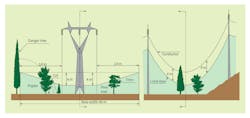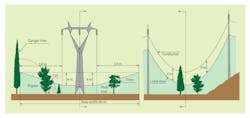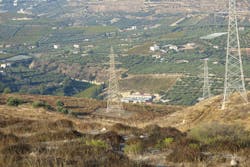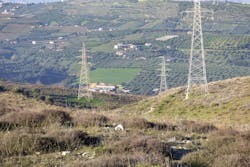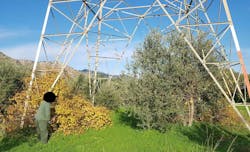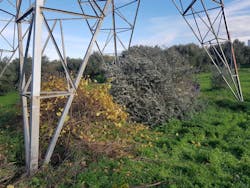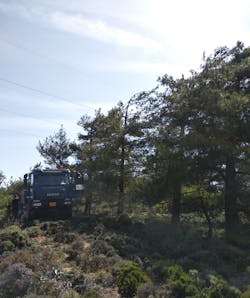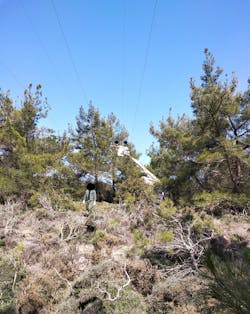Transmission utilities are expected to manage vegetation, including trees, within a right-of-way (ROW) corridor at a certain width under a transmission line. They must do so in a way that ensures the safe operation of the line, provides easy and safe access for inspection and maintenance purposes, and respects the surrounding environment and established developments in the area.
The exact policy each utility follows depends on the legislation and regulations in force, which vary among countries and, sometimes, even different locales within a country. Additional factors such as public opposition and the price of land also must be considered. In general, if acquiring the land is not an option, then utilities acquire easement rights. Often enough, such easements are acquired through expropriation, leading to less actual rights over the area in comparison to an actual purchase. In Greece, the construction of a transmission line is treated as a work of public interest, and the land and easements necessary for the construction, safe operation and maintenance of the line are acquired through expropriation.
The Hellenic Electricity Distribution Network Operator S.A. (HEDNO) manages the power systems in the Greek islands of Crete and Rhodes on behalf of the Public Power Corp. S. A. (PPC), which has full ownership of the base area of each tower and easement rights of ROW corridors. Besides managing vegetation in the base areas to ensure personnel can access towers, the utility also is required to keep the area around the base fully clear of all vegetation in accordance with fire-prevention legislation. While the utility can enforce height restrictions on buildings in a ROW corridor and must follow the same height restriction in the case of trees, it does not have the ability to restrict the types of vegetation or kinds of trees in a corridor, which can be quite challenging.
The Crete and Rhodes Case
Historically in Greece, the construction, operation and maintenance of transmission lines were undertaken by the PPC. After the 2011 split of PPC, these duties were transferred to the independent power transmission operator (IPTO) for the entire country, with the exception of the isolated transmission systems on the islands of Crete and Rhodes, which fall under the jurisdiction of HEDNO’s islands network operation department.
The 150-kV, 50-Hz power systems in both Crete and Rhodes are fully isolated (this is expected to change soon in Crete). Transmission lines interconnect 20 high-voltage substations in Crete and six in Rhodes. The total length of transmission lines in Crete currently is more than 580 km (360 miles), spanning over double-circuit and single-circuit lines supported by more than 1600 lattice towers and metal poles. In Rhodes, the accumulated length of the transmission lines currently is more than 145 km (90 miles), again spanning over double-circuit and single-circuit lines, supported by more than 400 lattice towers and metal poles. The length of single-circuit lines in Crete is about three times the length of double-circuit lines, whereas the length of double-circuit lines in Rhodes is about five times the length of single-circuit lines.
Aspects of vegetation management vary in each case. In Crete, the major issue is the clearance of the base areas of tension towers because of their number, their spread-out location and the longer routes leading to them. Occasional tree trimming is required but to a lesser extent compared with Rhodes, where large sections of double- and single-circuit lines span over forest areas.
Tree Trimming Guidelines
Tree trimming is an issue as old as transmission lines. The development of the transmission system in Greece began in 1953. Tree trimming instructions issued back in 1957 (before the construction of any transmission lines in Crete and Rhodes) can be found in the hard-copy archives of the transmission line subsection of HEDNO’s islands network operation department in Heraklion, Crete.
The tree trimming policy basically remains the same today. In general, all trees within the ROW corridor posing a hazard to the line must be trimmed to maintain a specific distance from the line. Olive and fruit trees are excluded because of their low maximum height.
Tree cutting is allowed only in special cases when trimming is not possible or considered dangerous (for example, when a bucket truck cannot reach the area and climbing is not advisable because of the tree’s height, location or general condition).
In Crete and Rhodes, tree trimming generally is performed by HEDNO’s own personnel, linemen from the transmission lines subsection, because the nature of this work calls for experienced personnel who are familiar with the transmission lines. Outside contractors are used only in cases where additional equipment or heavier machinery not owned by HEDNO, such as large cranes, are needed.
Residential and Agricultural Areas
Besides the trimming rules — which are similar for most, if not all, utilities — it is important to note some of the country’s peculiarities. In Greece, any kind of tree can be planted and grown within the ROW corridor. The utility, which does not own the trees, has a legal obligation to ensure the trees are trimmed at the right height and do not pose a hazard to the line.
Furthermore, the utility must ensure trimming is performed in a way that does not endanger the tree’s well-being. If the utility decides a tree must be cut or the trimming results in the death of a tree, then the tree owner may have to be compensated. It would certainly be much safer and more cost effective to enforce restrictions on the kinds of trees that can be planted in a ROW corridor (for example, prohibiting the planting of hazardous trees and allowing them to be cut at an early stage) and also place some, or all, of the responsibility on landowners.
This approach may be attributed to easements being acquired through expropriation, usually at low cost. This has led the state and utilities to adopt a passive behavior as much as possible toward the owners of ROW corridors to avoid conflicts and major public opposition to the construction and operation of transmission lines.
Such issues are rare, however, as transmission line routes generally are remote, typically in areas where tall trees are rarely planted for recreational or other purposes. Fortunately, most of the privately owned trees found under transmission lines, especially in Crete and Rhodes, are olive and fruit trees that do not reach hazardous heights in their lifetime. On rare occasions, some isolated tall trees may still be found on the banks of river streams or in areas not used agriculturally.
Focus on Forests
When a transmission line is routed through a forest, tree trimming is an entirely different matter. Forest areas are public property in Greece and heavily protected by law. The national Forest Service is responsible for creating and maintaining fire break zones. It does not collaborate with transmission utilities on this and, thus, ROW corridors are not used (or allowed to be used) as fire break zones.
Clearing them to be used as pedestrian zones also is out of the question. Instead, utilities are expected to trim all trees in the ROW corridor, maintaining them at just the right height. Tree trimming must be performed under the supervision of the Forest Service, and tree cutting is only allowed in rather dangerous cases. This policy not only adds significant difficulties to the work of the utility, it also puts the safety of the forest, transmission system and utility field crews at risk.
Firstly, deenergizing the line may be necessary, which adds stress and risk for transmission systems operation. Secondly, heavy machinery and tree climbing may be required for correct trimming. This can potentially lead to uprooted trees and branches falling on the personnel performing the trimming or even working in the ROW corridor prior to, or after, trimming. Thirdly, there is the risk of misjudging the height difference or growth rate of a tree. The no-clearing-the-ROW-corridor policy also increases the potential for branches on neighboring trees to break and be carried onto the line by wind. Fourthly, just having personnel moving around in the forest following crooked routes, instead of moving in a fully cleared ROW corridor, is a dangerous and time-consuming procedure, because roads hardly exist or are barely maintained. In general, moving inside forests is largely discouraged and even considered illegal at certain times by the Greek state and Forest Service for fire-prevention reasons.
In countries where ROW corridors can be kept clear of trees, the latest reports show inspections using aerial vehicles (unmanned or not) can easily and very cost effectively locate branches closing in on a line from the sides. In Greece, however, with its no-clearing-the-ROW-corridor policy, such techniques would not offer much service.
Tower Base Areas
Vegetation management usually is aimed at securing the safe operation of the transmission line as well as easy and safe access to the supporting structures. As the utility owns the land of the base area of each tower, managing the vegetation within that area is a simple procedure that can be adjusted by utilities as needed.
In Crete and Rhodes, the typical approach is to note during periodic line inspections any vegetation within the base area of suspension towers that hinders the work of linemen, and the clearing usually gets completed later. Such clearing is restricted to the area owned by the utility and generally aims to ensure safe access and work by the line crew. It is considered a low-priority task and, thus, is performed as supplementary work when schedules allow, thus increasing productivity and keeping costs low. On the other hand, this approach may result in the clearing of certain base areas being postponed as a result of scheduling conflicts or emergencies in other parts of the network. In certain cases, when vegetation has reached an excessive state, outside contractors are called in to help.
Apart from suspension towers, the case is different with all other types of towers. In Greece, utilities are required by law to clear all vegetation within a certain distance from any connection point of the network to minimize fire hazards. In case of transmission lines, the only connection points are the jumpers, that is, the bridging parts found on terminal, transposition and tension towers.
Thus, a larger area around the base of 287 such towers in Crete and 117 in Rhodes must be kept clear of vegetation throughout the fire danger period (from May to October). This is a task largely assigned to outside contractors in both Crete and Rhodes, as it is a safe and simple procedure that requires no special expertise but takes a lot of time to complete. The process should be performed keeping in mind that towers may be located within or next to private areas as well as areas of agricultural or environmental interest such as forests. Thus, the use of herbicides, if permitted at all, still must conform to several restrictions.
Therefore, this work mostly is performed using manual labor (workers with grass cutters and pickaxes) and has a direct impact on short-term re- sults because the clearance must often be repeated twice in the fire danger period. It also affects long-term results, with no significant alteration on vegetation quantity or quality through the years.
Final Thoughts
Vegetation management, including tree trimming, is an important aspect of transmission lines operation and management. The actual approach by the utilities in charge largely depends on the regulations and legislation in force.
In the case of Greece, utilities must comply with peculiar rules. For example, they bear the responsibility to keep areas around the base of tension towers fully clear of vegetation. They also must ensure all potentially dangerous trees inside ROW corridors are trimmed at just the right height without the ability to restrict the types of vegetation or kinds of trees. They also are not allowed to perform extended clearing of ROW corridors. Ultimately, this approach results in increased costs and risks to the transmission system, the utility’s employees, the public and the environment.
About the Author
D. Pylarinos
Dr. D. Pylarinos is in charge of the overhead transmission line crew and the easements and ROW office for the Crete-Rhodes transmission system operation section of HEDNO. Before that, he worked in several positions in both industry and academia. He is the editor-in-chief of the Engineering, Technology & Applied Science Research journal. He has written more than 60 published works, including papers, chapters and books. He earned his PhD in electrical and computer engineering from the University of Patras, Greece, in 2012.
